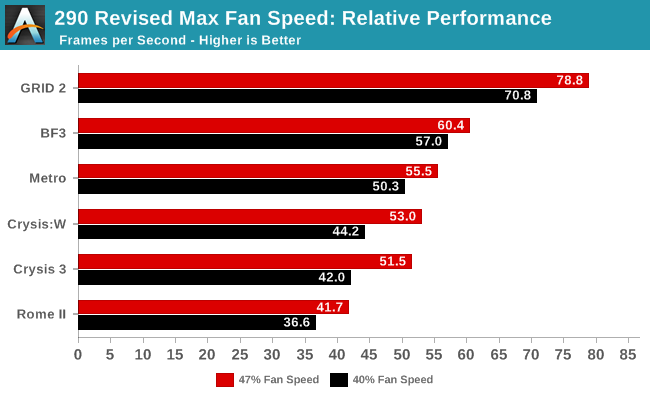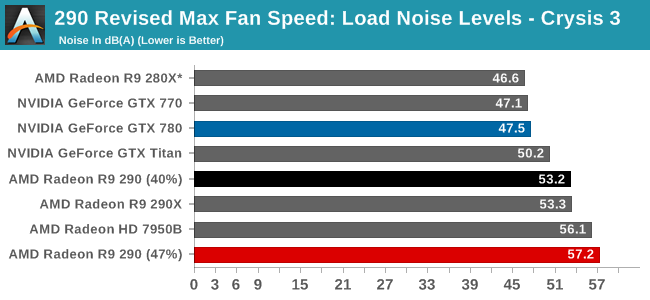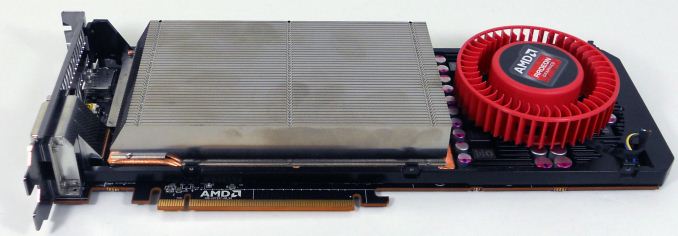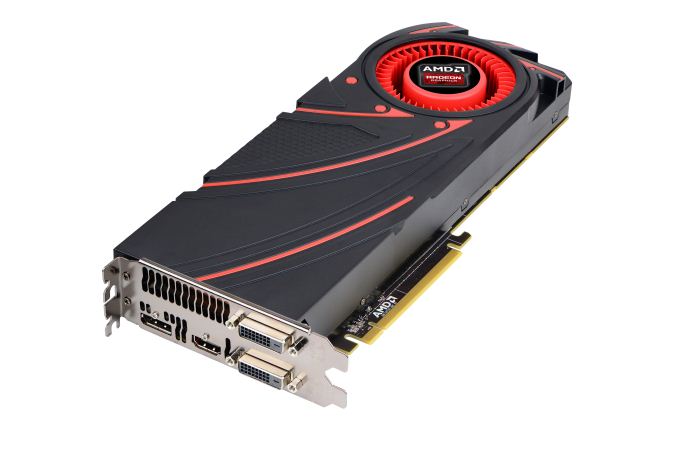The AMD Radeon R9 290 Review
by Ryan Smith on November 5, 2013 12:01 AM EST- Posted in
- GPUs
- AMD
- Radeon
- Hawaii
- Radeon 200
AMD's Last Minute 290 Revision
As we alluded to at the start of this review, the launch of the 290 series has put both AMD and NVIDIA in a state of rapid response. NVIDIA has needed to make adjustments in response to AMD’s new products, and in turn AMD has needed to make adjustments to their own products to take into account NVIDIA’s adjustments. In a more typical launch cycle this process may be more spread out – and in most cases, all adjustments will happen before the first new video card is even launched – but like AMD’s launch schedule itself all of these adjustments have become compressed.
This is no more evident across AMD’s product lineup than it is for the Radeon R9 290, which even by video card launch standards received a very late specification adjustment. Review samples started arriving on Friday, October 25th (the day after the 290X launch) with a planned launch date of Thursday the 31st, only for AMD to push back the launch late on Monday the 28th, doing so just 48 hours before the 290 was meant to be launched. Pushing back the launch, with hardware already in our hands and many benchmarks already complete, AMD issued a new launch date of today (November 5th) and alongside it changed their competitive positioning, giving the 290 a specification adjustment in the process.
The end result is this: while the 290 was originally slated to go up against the $400 GTX 770, in response to NVIDIA’s price cuts AMD decided to make a run at the newly repriced $500 GTX 780 instead. To do so and to be able to meaningfully challenge the GTX 780, AMD would have to make the 290 faster than its original configuration, which in turn necessitated the specification change. As a result this has been one of the wildest video card launches in some time, easily rivaling the launch of the Radeon HD 4870.
So what’s changed between the original 290 and the new 290 as we know it? With 290 hardware already in the hands of reviewers and being shipped out to retailers for the original launch date, it’s already too late for AMD to change the clockspeeds or CU configurations; all of that was validated and burnt into GPUs and BIOSes long ago. Never mind the fact that AMD has already binned these chips for the existing 290 clockspeeds and voltages, so higher clockspeeds would require a new binning and reduce yields in the process. As a result what hasn’t changed are the formal clockspeeds; 290 was and remains a 947MHz boost clock product with 40 active CUs and 4GB of 5GHz GDDR5.
| Radeon R9 290 Specification Changes | ||||
| AMD Radeon R9 290 (Revised) | AMD Radeon R9 290 (Original) | |||
| Stream Processors | 2560 | 2560 | ||
| Texture Units | 160 | 160 | ||
| ROPs | 64 | 64 | ||
| Core Clock | 662MHz | 662MHz | ||
| Boost Clock | 947MHz | 947MHz | ||
| Memory Clock | 5GHz GDDR5 | 5GHz GDDR5 | ||
| Memory Bus Width | 512-bit | 512-bit | ||
| VRAM | 4GB | 4GB | ||
| Typical Board Power | ~300W (Unofficial) | ~300W (Unofficial) | ||
| Max Fan Speed | 47% | 40% | ||
| Intended Competitor | GeForce GTX 780 | GeForce GTX 770 | ||
What has changed is the default fan speed. As you might recall from our 290X review, the 290X can’t actually sustain its 1000MHz boost clock at its default fan limit of 40%. The amount of heat generated at those clockspeeds and voltages is just too great for the cooler, and as a result the card has to pull back, significantly at times, in order to keep itself within tolerances with the amount of cooling provided at a 40% fan speed. Like the 290X, the 290 as originally specified would also have a default fan speed of 40%, and like the 290X it too would throttle under just about all sustained workloads. Or as AMD likes to put it, the 40% fan speed on the original 290 would have left “untapped performance headroom.”
So for the new 290 as will be reviewed and shipping, AMD has turned up the default fan speed from 40% to 47%, essentially making uber mode the default mode on the 290. Consequently with improved cooling performance the 290 throttles less (if at all), thereby improving its performance despite the other specifications technically remaining the same. Or to put this another way, AMD was able to significantly increase their performance merely by turning up the fan speed and reducing the thermal throttling that was holding back the card’s performance.
Of course there are some very clear, very important tradeoffs for doing this. As this is the same cooler that was on the 290X, the acoustic profile on the 290 is identical to the 290X. That means that at the original 40% default the amount of noise coming from the card is just north of 53dB, a level that’s louder than NVIDIA’s competing cards and just on the edge of reasonable noise levels overall. Going above 40% further improves the cooling performance of the card, but it moves the noise levels into “unreasonable” territory, with the increase to 47% causing an equally significant increase in noise.
To give you an idea of both the performance improvement and the noise increase from AMD’s last minute specification change, we’ve run a selection of our games at 2560x1440 both on the originally specified 290, and the 290 with its new shipping specification.
| Radeon R9 290 Average Clockspeeds | ||||
| 47% Fan (Revised) | 40% Fan (Original) | |||
| Boost Clock | 947MHz | 947MHz | ||
| Metro: LL |
947MHz
|
830MHz
|
||
| Battlefield 3 |
947MHz
|
870MHz
|
||
| Crysis 3 |
947MHz
|
720MHz
|
||
| Crysis: Warhead |
947MHz
|
662MHz
|
||
| TW: Rome 2 |
947MHz
|
761MHz
|
||
| GRID 2 |
947MHz
|
825MHz
|
||

AMD’s fan speed adjustment had a significant impact on gaming performance. At 47% the fan speed on the 290 is now fast enough – and just so – to eliminate thermal throttling on the card under any gaming workload. As a result sustained clockspeeds that were anywhere between 870MHz and 662MHz (the base clock) have become 947MHz across the board. Consequently the overall performance increase from doing this is 14%, which is larger than the performance gap between some cards. At 40% the 290 was getting throttled so badly that just by increasing the fan speed AMD was able to essentially reinvent the 290 as a higher performance SKU without changing the hardware.
But the acoustic costs are equally significant.

We’ll have a full breakdown of the matter later on in our article, but briefly the acoustic cost of increasing the 290’s fan speed from 40% to 47% is a 4dB rise in noise. 290X was just shy of being 6dB louder than GTX 780, and with 290 that gap is now just shy of 10dB, twice the loudness on a perceptual basis. It’s very much a pyrrhic victory for AMD; 290 is now an incredibly fast card for the price, but the noise levels are unreasonable and border on the absurd.
On a final note on the matter, how AMD is distributing the revised fan speed specification is also a little different than anything we’ve seen them do before. With it being too late to reprogram the first wave of cards – remember, at this point they’re already boxed up for retailers – AMD has programmed the change into their drivers instead. So for the 290 with Catalyst 13.11 Beta v8 and later, AMD will override the BIOS default of 40% and put it at 47%, making this the rumored "AMD performance driver" that some have been expecing to be released alongside the 290. Meanwhile the next wave of cards will presumably come pre-programmed with the new 47% specification.
Meet The Radeon R9 290
Having gone over AMD’s last minute 290 revision, let’s briefly go over the hardware itself. Since the 290 is based on the exact same reference design as last month’s 290X, the hardware is identical with the exception of the changes in the GPU configuration and the aforementioned fan speed changes. As such, compared to the 290X there are no changes on a physical basis.
Starting as always from the top, the 290 measures in at 10.95”. The PCB itself is a bit shorter at 10.5”, but like the 7970 the metal frame/baseplate that is affixed to the board adds a bit of length to the complete card. Meanwhile AMD’s shroud sports a new design, one which is shared across the 200 series. Functionally it’s identical to the 7900 series, being made of similar material and ventilating in the same manner.
Pulling off the top of the shroud, we can see in full detail AMD’s cooling assembling, including the heatsink, radial fan, and the metal baseplate. AMD is still using a covered aluminum block heatsink designed specifically for use in blower designs, which runs most of the length of the card between the fan and PCIe bracket. Connecting the heatsink to the GPU is an equally large vapor chamber cooler, which is in turn mounted to the GPU using AMD’s screen printed, high performance phase change TIM. The radial fan providing airflow is the same 75mm diameter fan we’ve seen in earlier AMD designs, and consequently the total heat capacity of this cooler will be similar, but not identical to earlier designs. With AMD running the 290 at a hotter 95C versus the 80C average of the 7900 series, this same cooler is actually able to move more heat despite being otherwise no more advanced.
Meanwhile for power delivery AMD is using a traditional 5+1 power phase setup, with power delivery being driven by their newly acquired IR 3567B controller. This will be plenty to drive the card at stock, but hardcore overclockers looking to attach the card to water or other exotic cooling will likely want to wait for something with a more robust power delivery system. As for memory, despite the 5GHz memory clockspeed for the 290, AMD has actually equipped the card with everyone’s favorite 6GHZ Hynix R0C modules. 16 of these modules are located around the GPU on the front side of the PCB, with thermal pads connecting them to the metal baseplate for cooling.
As for display connectivity, the 290 utilizes AMD’s new reference design of 2x DL-DVI-D, 1x HDMI, and 1x DisplayPort. Compared to the 7900 series AMD has dropped the two Mini DisplayPorts for a single full-size DisplayPort, and brought back the second DVI port. Note that unlike some of AMD’s more recent cards these are both physically and electrically DL-DVI ports, so the card can drive 2 DL-DVI monitors out of the box; the second DL-DVI port isn’t just for show. But as a compromise of this design – specifically, making the second DVI port full DL-DVI – AMD had to give up the second DisplayPort, which is why the full sized DisplayPort is back.
Moving on, AMD’s dual BIOS functionality is back once more, but unlike the 290X the second BIOS will not be serving any defined purpose. Both BIOSes are identical as AMD doesn’t have an uber mode for the 290, so switching between the two will not change the card’s performance in any way. In this setup the second BIOS is reduced to serving as a safety net for end-user BIOS flashing.
Finally, let’s wrap things up by talking about miscellaneous power and data connectors. With AMD having gone with bridgeless (XDMA) Crossfire for the 290 series, the Crossfire connectors that have adorned high-end AMD cards for years are now gone. Other than the BIOS switch, the only thing you will find at the top of the card are the traditional PCIe power sockets. AMD is using the traditional 6pin + 8pin setup here, and not the 6pin + 6pin setup seen in the first pictures of the card. Thse sockets when combined with the PCIe slot power are good for delivering 300W to the card, which is what we estimate to be the card’s TDP limit. Consequently overclocking boards are all but sure to go the 8pin + 8pin route once those eventually arrive.














295 Comments
View All Comments
swing848 - Tuesday, November 5, 2013 - link
It will only get loud for me when playing games or the occasional benchmark. During games I weara headset, and during benchmarks I can leave the room. I have a room dedicated to computer use
and the house has good sound proofing, so, it will not bother other people.
If I want it quiet I will use a water cooler with a large radiator and fan, my Cooler Master HAF
922 case already has sealed holes for tubing for an external radiator.
Water cooling is better than dumping all the hot air from the video card into my case, even if it
is well cooled with 200mm fans. I overclock my CPU and I do not want it, RAM, or chips on the
motherboard to get any hotter than necessary.
The only thing I will miss on this card are Black Diamond Chokes and Digital Power 8+2+2 phase
used on the Sapphire R9 280X Toxic [Black Diamond Chokes are also used on Sapphire R9 280 Vapor-
X]. To be honest I do not know how many mosfits are dedicated to cool GPU functions on the R9
290. In any event, both the Toxic and Vapor-X dump hot air into the case.
Another thing I would like to have seen on the Sapphire R9 290 is a metal back plate.
somethingwicked - Tuesday, November 5, 2013 - link
what the holy gee whizthe new AMD drivers are insane! 290x is speeding past Titan now and 780 is a turtle while 290x is a ferrari... the new 290 is performing like the 290x was at launch and now the 290x is a card unto its self at the top of the food chain
thank goodness for competition
i smell more deep nvidia price cuts cause AMD is kicking butt
TheJian - Tuesday, November 5, 2013 - link
rofl. So NV just has to release a "fan that drives you out of the room" driver now to respond. IF NV did this all of you would be falling all over yourselves to moan and groan claiming NV was cheating. AMD does it, and wow this is awesome, I love the noise anyway...LOL. Technically this is all NV has to do though right? Raise the fan speed until it hits another 10DB's and blow them down again.Perf is great, but not if it drives me out of my room. There is nothing stopping NV from adding 10DB's to their cards and calling it a day. But I don't want this being called normal. IMHO this is a crap way to get perf and a game both sides can play. If NV does this tomorrow and says we're hiking prices because if we overclock our cards also (which is essentially what they're doing here, just reverse, raise fan so clocks boost higher, same story) we blow AMD away.
https://www.youtube.com/watch?v=djvZaHHU4I8
Both cards clocked to max (290x vx. 780, NOT TI mind you).
Fast forward to 8:40 for benchmarks...AMD is blown away. The 780 didn't lose ANY game. Not one. And in star citizen blows AMD away. I don't believe these cards will be used mostly on 1600P or 1440p either. 1080/1200p is running on 98.5% of our screens and a large portion of the 1.5% that is above these two resolutions are running TWO or more cards. Steam's surveys don't lie. Already they turn down nearly every game at 1440p here which to me means you won't run there anyway (they are not reporting mins here for most games). Everything is pretty maxed in linustechtips vid above at 1080p, and you should be able to stay above 30fps (probably?) doing it. They are reporting avg's here at anandtech and already turning stuff down. Meaning maxing graphics on a lot of games would be unplayable under 30fps especially when lots of crap is going on. LOW DETAIL? Seriously? So Ryan is assuming you'll buy one of these cards (or any single gpu card) to then go out and buy a 1440p monitor (which are still over $550 for any brand you'd recognize the name of on newegg, and start there when you choose NEWEGG ONLY) and then run the details on low to play games? I don't think so. If he's assuming we're all going to buy new monitors, might as well get Gsync instead (though I'd say wait for more models first even if Asus has a decent one out of the gate). Heck some of the games have details DOWN on 1080p here (total war2, medium shadows? still looks like it would hit below 30fps on most cards).
For anyone saying get a water block...LOL. How much did my card cost if I have to add that and how many regular users even know what water is or are even capable of adding one? I say that as a guy who has as Koolance kit. Or even adding an aftermarket fan. Isn't this upping the cost of the card then?
Both solutions are unacceptable and attempting to fix a problem caused by shipping a card that already is unacceptably NOISY, hot and sucking up watts vs. it's competition. No games either.
Add on top reviews elsewhere show other games that give an opposite story. Techpowerup, Techspot, Guru3d, Hardocp show wins for AC3, COD Blackops2, Diablo3 (spanked by NV), FarCry3, SplinterCell Blacklist, Star Craft2 (spanked, heck 770 does well), World of Warcraft (spanked), Skyrim (lost 3 resolutions, 290/x won 1600p, oddly lost upping to 5760), Resident Evil 6.
So maybe you need to take a bit of a WIDER view than anandtech ;) I don't call 53 more watts than 780 (or 70 more than 770) a victory. Never mind the noise it creates while doing it. Is running 10DB's higher really a better card? Do people here realize that noise in DB's is EXPONENTIAL? A 10Db noise difference is HUGE (ryan did say 2x as loud). 12 degress hotter for this kind of perf isn't good either. I see a clear reason NV should be charging more than AMD's cards. They are better. I can OC and beat them easily without all the noise, heat, watts. I don't need a waterblock to do this either...ROFL. Whatever I already have on my card can do this easily and come in UNDER Ryan's 7970 noise levels that he calls acceptable.
I see no price cuts, but probably a few more videos poking fun at AMD like this:
https://www.youtube.com/watch?v=oV5vs27wnCA
Tell me that isn't funny ;) I'm wondering if someone at NV paid for this vid to be made...LOL. Sparks, dripping fire, ROFL. Great job of getting the message across.
rviswas11 - Tuesday, November 5, 2013 - link
i couldn't give two s***ts because when i game i wear noise cancelling headphones that i use for listening to music on the busrviswas11 - Tuesday, November 5, 2013 - link
so i'm happy. and with the exception of skyrim i could set the graphics card to 10% fan profile and max the game. i run quite afew mods for skyrim don't play it anymore.but i can see how the noise can be a major issue for a lot of people.
Morawka - Tuesday, November 5, 2013 - link
your not understanding. At this level of noise, not even noise canceling headphones will drown it out. This is louder than a 747 jet from 100 meters away.mgl888 - Tuesday, November 5, 2013 - link
You'd better be trolling.60dB is the intensity of a normal conversation.
Galidou - Tuesday, November 5, 2013 - link
Comon, a 747 jet 100 meters away... you gotta be freaking stupid to only think it could be true :Oahlan - Saturday, November 9, 2013 - link
@GalidouWhat do expect from nvidia fantards who think higher price is better.
They are so unsecure and delusional that they comment in every AMD review...
Nvidia is loving their stupidness...
1Angelreloaded - Saturday, November 16, 2013 - link
120 decibels is a 747 I would know I work around them, But AMDs new cards are crap, 550$ to add a water cooling system totaling around 200-300$.......either way its not a deal really, Nvidia cards have more headroom on air and water, while AMD's cards are impressive to an extent Hawaii is a bastard step child of sorts, it is probably a failed version of the next chip to compete with Maxwell but had no choice but to release it.